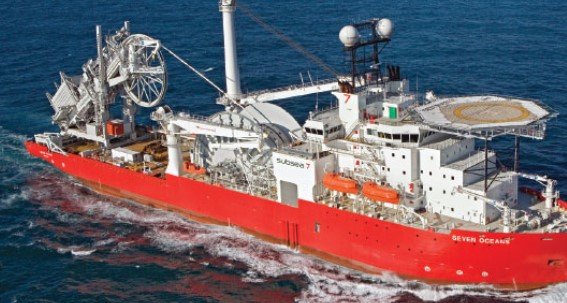New subsea project adds to Egypt’s deepwater momentum as energy sector stays upbeat
Subsea7 just landed a fresh offshore contract in Egypt that could be worth as much as $150 million, adding another layer to the country’s increasingly active subsea play.
The Oslo-listed engineering group confirmed the deal early Monday, describing it as “sizeable” — code for a value between $50 million and $150 million, per company lingo. The project involves engineering, procurement, commissioning, and installation (EPCI) work on flexible pipelines, umbilicals, and other subsea hardware to support a tie-back to existing offshore platforms.
And while neither the client nor field name has been made public — a familiar move in tightly held offshore circles — insiders say the project fits Egypt’s ongoing push to ramp up subsea activity as it leans into gas and condensate development in the Mediterranean.
A quiet win in a tight offshore market
In today’s offshore contracting world, “sizeable” doesn’t always mean small. For subsea contractors like Subsea7, which operate in a narrow margin, high-risk business, even a mid-tier EPCI award like this one can mean months of stability and crucial backlog.
Engineering work is kicking off right away, with project management spread across teams in France, Portugal, and Egypt.

“The value of early alignment can’t be overstated,” said David Bertin, Subsea7’s senior VP for GPC East. He added that getting involved from the start allows both the client and Subsea7 to fine-tune designs, reduce risk, and drive down cost.
That’s corporate speak for: let’s avoid surprises later.
Egypt’s offshore ambition keeps growing
For Egypt, this project is another notch on a belt that’s already looking well worn. Over the past decade, the country has transformed from regional laggard to gas heavyweight, thanks to discoveries like Zohr and targeted brownfield reinvestment.
But lately, it’s not just the supergiants getting attention.
Smaller tie-backs — linking new production wells to existing platforms — have become increasingly common in the East Med. They’re faster, cheaper, and easier to sanction in a volatile market.
And for companies like Subsea7, they offer predictable work without the budget blowouts.
Here’s a quick glance at Egypt’s recent offshore pipeline:
| Project Name | Developer | Type | Status |
|---|---|---|---|
| Zohr Phase 2 | Eni | Gas | Operational |
| Atoll Extension | BP | Gas | In development |
| West Delta Deep | Multiple | Oil & Gas | Expanding |
| Subsea7 Tie-Back | Undisclosed Client | Subsea Gas Tie | Starts 2026 |
Why these smaller deals still matter
It might not grab the same headlines as billion-dollar megaprojects, but this contract matters — and not just for Subsea7.
Projects like these have a multiplier effect in countries like Egypt:
-
They extend the life of existing platforms by several years
-
They open up jobs across fabrication, engineering, and offshore marine services
-
They allow operators to keep gas production stable without new infrastructure
That last point hits particularly hard as Egypt wrestles with both local power demand and export ambitions via its LNG terminals.
Subsea7’s regional playbook
If you look at Subsea7’s footprint, the Egypt award fits nicely into a strategy that’s leaning heavier on the Eastern Hemisphere. Over the past few years, the company has been scaling back in North America and hedging more bets in Africa, the Middle East, and Asia.
And it’s working. The company’s Q1 2025 earnings showed an order backlog of $7.8 billion — its healthiest in nearly five years — with more than 40% of that tied to the Eastern Hemisphere.
What makes this contract interesting is the tri-country execution: France, Portugal, and Egypt.
That mix tells you the project isn’t just local pipe laying. It likely involves specialized design work in Europe, a bit of component fabrication, and then localized execution using Egyptian marine assets or shipyards.
One senior industry analyst in Cairo, speaking anonymously because they weren’t authorized to comment, said: “The project is a classic tie-back. Nothing flashy. But it shows that Egypt remains a dependable place to do subsea business — provided you know who to talk to.”
The road to 2026: What comes next
Actual offshore work is slated for 2026 — which in offshore terms, is just around the corner.
That means:
-
Vessel schedules will need to be locked in by mid-2025
-
Pipe welding and testing will start by Q4 this year
-
Offshore crews will begin mobilizing from Egypt or Europe sometime next summer
Right now, Egypt’s offshore window is tight — with weather, geopolitics, and vessel traffic all playing a role.
Subsea7 will need to thread the needle. But if their track record in the region is any clue, they’re already on it.
Not just a contract — a quiet vote of confidence
This isn’t just about steel and seabed.
The award, while modest, is a quiet vote of confidence in Egypt’s offshore sector at a time when some foreign investors remain jittery over FX restrictions, subsidy reforms, and domestic power outages.
And yet here’s a $50–150 million subsea contract being booked, planned, and staffed. That says something.
For local suppliers and engineers, it means steady work. For Egypt’s government, it means more hydrocarbon volumes with minimal new spending. For Subsea7, it means another solid win in a region that’s still showing promise — even if the spotlight’s moved elsewhere.
